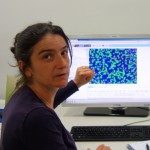Link to Pubmed [PMID] – 18024113
Bioorg. Med. Chem. Lett. 2008 Jan;18(1):329-35
We describe here a series of N-(quinolin-8-yl)benzenesulfonamides capable of suppressing the NFkappaB pathway identified from two high-throughput screens run at two centers of the NIH Molecular Libraries Initiative. These small molecules were confirmed in both primary and secondary assays of NFkappaB activation and expanded upon through analogue synthesis. The series exhibited potencies in the cell-based assays at as low as 0.6 microM, and several indications suggest that the targeted activity lies within a common region of the NFkappaB pathway.


